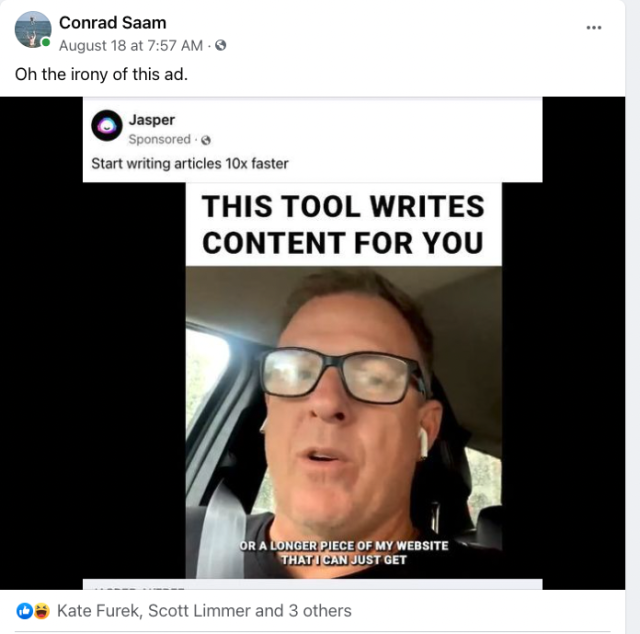Google’s Helpful Content Update (Lawyer Edition)
It’s not often that Google announces an upcoming algorithm change, and when they do, it typically means a major changes in overall SERP results. My prognostication is that the Helpful Content update, announced late last week and scheduled for a two week roll-out starting this week, is no different. While the legal industry is not specifically called out as being problematic, I do anticipate large fluctuations due to many overly aggressive tactics deployed by legal, especially as it pertains to content. Google directly described the upcoming change as “meaningful”.
The Helpful Content Update (seriously – why can’t we just call this HICUP?) update in Google’s own words:
These launches are part of a broader, ongoing effort to reduce low-quality content and make it easier to find content that feels authentic and useful in Search.
What does this mean concretely for law firms?

Last week, I presciently posted this ad for a content development tool that uses AI to pump out pages and pages of content: “Let Jasper Write Your Marketing Copy for Free Artificial intelligence makes it fast and easy to create content for your blog, social media, website, and more!” From what I can tell from Google’s announcement, it’s tools like Jasper that are firmly within the targets of the “Helpful Content” algo update.
This update is extremely similar to the Panda update from February, 2011. For those of you who weren’t in the SEO game at that point – what happened in the past may be instructive of what to expect over the upcoming months. Panda was designed to root out content farms that were daily vomiting out thousands of pages of well ranking pages and monetizing that traffic through advertising. While the key targets were Demand Media (eHow) and Answers.com; many many other sites were caught up in the resulting algo update which focused on content. The key issue here is that the Panda algo update had site-wide ramifications, which meant that a predominance of low quality content on a domain would negatively impact the traffic to high quality pages as well. Following Panda, Google noted that it impacted 12% of searches – meaningful indeed.
Prognostications
I spent the weekend reading through posts and prognostications of some of my favorite SEO nerds and Google directly. Based on my experience with Panda and parsing Google’s announcement, here’s my expectations of what’s going to happen:
- Some legal sites are going to get utterly destroyed. Especially those that have deployed AI written content. I’ve long been a critique of the blog blog blog mantra and believe this is going to come back to roost. There are a slew of legal marketing agencies who utilize AI generated content and then mark it up to human rates to their clients… meaning the law firms (may) have no idea they’ve been deploying a steady diet of vapid computer generated content that will be targeted. If your relationship with your SEO vendor includes something along the lines of…. “post 11 pieces of content every month”, I’d be particularly concerned. This goes for the small consultants as well as some of the big box providers.
- Given that there’s so much long tail content out there, and much of that has been AI driven, I’d expect to see large variability in ranking results for long tail terms. This is, by definition, statistically difficult to ascertain, especially for lower traffic sites.
- In general, I’ve avoided Word Count guidelines (ie. Google like to see X number of words on pages). However, over the past 24 months, we’ve seen a trend towards longer format content ranking – 1,000-1,500 words. It’s very possible that this trend reverses – Google specifically calls out word count as NOT being a ranking factor. Google even calls out Word County focus as a particular concern: “Are you writing to a particular word count because you’ve heard or read that Google has a preferred word count?” From a precedent perspective, Panda specifically hit pages with inflated word count that thematically recycled concepts in order to bolster keyword density. From a user perspective, overly verbose, redundant and repetitive prose (see what I did there) doesn’t always serve to easily elucidate consumers as to their legal issue and options.
- I think there’s a mild warning for those sites that heavily utilize Practice Area + Geo Pages to rank in nearby cities. “Rockville Criminal Defense Lawyer” “North Rockville Criminal Defense Lawyer” etc. Those pages have always fallen in the (very) gray hate area wrt to search guidelines; however, they do perform very well. They are also painstaking to recreate with unique content. It’s possible poor executions of this tactic may be impacted as well.
- I don’t believe those pages sites that are plagued with thin useless pages that are either unintentionally generated through technology (think WordPress /tag pages) or those blog posts that are particularly useless (2 sentences in the “Mary Jones Won Superlawyers in 2014” blog post) are going to be hit any harder than they already are (which would be a departure of how Panda impacted sites). But again, this is just my conjecture from parsing Google’s wording – “search engine-first content is less likely to perform” and I believe that Google has long abandoned the notion that posting frequently is the key to SEO (despite the fact that many agencies and content consultants still preach this garbage).
- While Google specifically doesn’t call this a penalty, this is purely semantics b/c it’s going to look a lot like a penalty (allbeit not manual). This also means recovery is going to be dependent on Google’s algo deciding when things are better (not a human).
- This is English only (for now)… so those of you with already garbage Spanish pages and technical implementations have nothing to fear other than competitors doing it the right way.
- Very loose construct, if you have over 1K indexed pages with extensive content, I’d be worried. Check out my article on calculating the Useless Content Ratio to see how poorly Google considers your content already.
What to Expecting (When You Are Expecting an SEO Nightmare)
- This algo update is going to take two weeks to roll out. Starting roughly today(ish). The next two weeks may showcase banana-boat-crazy fluctuations in your site’s ranking and traffic performance. Ride it out.
- If you do get hit negatively, possibly expect a long recovery – even assuming you can identify and solve problems expediently, Panda recovery took many months b/c Google didn’t rerun updates for a long period. Helpful Content is different from Panda in that is constantly running; but I believe fixing this problem is a human, non-scaleable solution.
- Instead of going a comprehensive Content Strategy Audit and review (which is painful, takes time and gets exponentially harder the larger your site) consider just no-indexing a bunch of pages as a short-term bandaid. John Mueller gives this approach a qualified endorsement: “noindex is fine. Consider if all we see are good signals for your site, that’s a good sign.”
- This won’t be ambiguous… In an interview with Glenn Gabe, Danny Sullivan noted “if a site is impacted by the Helpful Content Update, then that impact should be visible”.
- The worse your overall content is the bigger the impact. From Sullivan: “sites with a lot of unhelpful content on the site, like content created for search engines over humans, then you could see a stronger effect…”
Human Content Alternatives
Get ready to yell at your agency about your content strategy. And if you are already panicking now, it’s time to a)start looking into managing your low end legacy content and b)start writing good great stuff! A great starting point for solid, legal specific content is John Reed at Rain BDM and Allen Watson at Blue Seven Content. Yeah – they expensive but if your site tanks, will look like a bargain.
